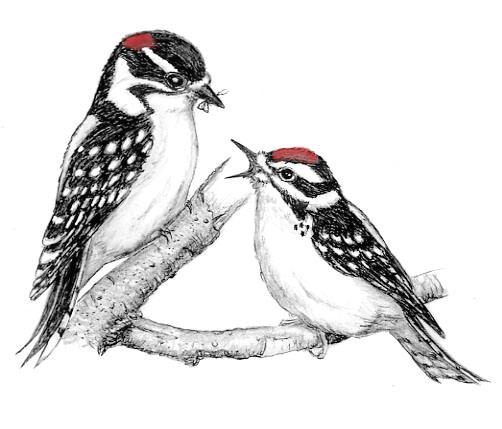
Dear Bird Folks,
I’m sure you’ve heard this before but I have a bird coming to my feeder that is not in any bird book. It looks and acts just like a Downy Woodpecker, but instead of having a patch of red on the back of its head this bird has red on its forehead. Do I have a rare bird coming to my feeder or is there something wrong with this downy?
– Sharon, Akron, OH
You are so right, Sharon,
I have heard that before. In fact, “not in any bird book” is among the most common statements I hear, right after “the birds are eating me out of house and home” and “man, you’re looking younger all the time.” (That last phrase is usually said very quietly, because I’m the only one who hears it, but I’m sure it’s being said.) Generally, when someone claims a bird is not in any bird book I roll my eyes, open up a book and point to the mystery bird. However, this is not the case with your bird. It truly isn’t in the books, or at least not in all of them. You see, your bird only exists for a month or two, and then it is gone forever. Pretty cool, eh? And it’s true.
The oddly colored bird that looks like a Downy Woodpecker is, in fact, a Downy Woodpecker. Now you are thinking: “Hold on, Bird Boy. The male downy has a red patch on the back of his head. The red on my bird is clearly on the forehead. What’s the deal with that?” The answer is simple. Sometimes when a woodpecker hammers on a tree trunk for too long, the red patch on the back of its head slips forward, like a cheap toupee. The poor bird doesn’t even realize it and may look this way for several days until some other woodpecker stops laughing long enough to point it out to him. The mortified bird quickly pushes the spot back to where it belongs and goes about his business. (Of course, that’s not the real answer to your question, but since the real answer is kind of dull, I thought I’d offer an alternative.)
The real answer is that you are simply seeing a brand new woodpecker. For a reason only known to them, young male Downy Woodpeckers have this odd red forehead patch for the first few weeks of their lives. Some baby birds have brown spots on them and others are kind of dull; however, newly fledged downies look very much like their parents, except the males have a red forehead. That’s it. That’s the whole story. The strange woodpecker you saw was nothing more than a baby bird in its baby bird plumage. See, wasn’t my toupee answer more interesting?
If you think you were caught off-guard by this weird baby woodpecker, Sharon, how do think its parents feel? Mr. and Mrs. Downy were trying hard to be the best parents they could be and somehow they ended up with a freak for a kid. (Boy, I sure know how they feel…and so do my parents.) If you listened closely to a woodpecker’s nest, you probably could hear the old man yelling: “Junior, you get that spot off your forehead this instant, young man.” And the fight goes on from there.
What makes things worse for the disgusted parents is that young woodpeckers stay in the nest much longer than most other birds. Typically, songbirds fly out of the nest ten days after they hatch. This is not the case with woodpeckers. Deep inside their safe tree trunk homes, woodpeckers have far fewer predators to worry about and thus can take much more time to grow. Downy chicks typically stay in their nests a full three weeks before venturing out into the world. The reason for the extended stay is because they need more time to develop their wings. A tree cavity may protect the birds from predators but the cramped quarters also prevent the little woodpeckers from exercising their wings. The extra time in the nest ensures that their wings are ready to go when it’s finally time to leave the nest.
After three long weeks, the adult woodpeckers have had enough of playing house and want the kids out. The kids, on the other hand, are afraid. They’ve never even flapped their wings before and are understandably reluctant to climb through the tiny entrance hole and jump into the unknown. But the parents have a plan. They slowly start cutting back on the food deliveries. The hungry kids stick their heads out of the hole yelling for grub, but the parents stand their ground and refuse to bring them a meal. Finally, because the parents won’t deliver, and neither will Domino’s, the kids are forced to leap from the nest hole and take their first flight…untested wings, goofy red patch, and all.
The reason for the mysterious red feather patch is unknown, Sharon. Perhaps it’s some form of sexist bird acne that only males get. Whatever the reason, the patch will be gone by September and your downy will look just like the ones in your bird book. However, if you can’t wait until then and want a book that has a picture of the bird you are seeing now, I know a great shop on Cape Cod where you can get one.